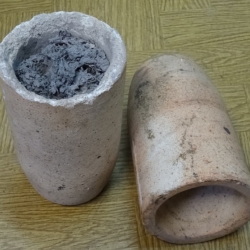Contributor(s): Shared on: Categories: Tags: | Source (Hebrew) | Translation (English) |
|---|
לְדָוִד |
David |
שׇׁפְטֵנִי יְהֹוָה
כִּי־אֲנִי בְּתֻמִּי הָלַכְתִּי
וּבַיהֹוָה בָּטַחְתִּי
לֹא אֶמְעָד׃
בְּחָנֵנִי יְהֹוָה וְנַסֵּנִי
(צרופה) [צׇרְפָה] כִלְיוֹתַי וְלִבִּי׃ |
YaH! Examine me;
notice that I walked with simplicity.
In You, YaH, I placed my trust;
I will not stumble.
Observe me YaH! See all of me;
help me clear my conscience and my heart. |
כִּי־חַסְדְּךָ לְנֶגֶד עֵינָי
וְהִתְהַלַּכְתִּי בַּאֲמִתֶּךָ׃
לֹא־יָשַׁבְתִּי
עִם־מְתֵי־שָׁוְא
וְעִם נַעֲלָמִים
לֹא אָבוֹא׃ |
Before my eyes I see Your Grace.
But if truth be my guide,
keep me from hanging out
with the criminals
who have secret agendas;
don’t let me partner with them. |
שָׂנֵאתִי קְהַל מְרֵעִים
וְעִם־רְשָׁעִים לֹא אֵשֵׁב׃
אֶרְחַץ
בְּנִקָּיוֹן כַּפָּי
וַאֲסֹבְבָה אֶת־מִזְבַּחֲךָ יְהֹוָה׃
לַשְׁמִעַ בְּקוֹל תּוֹדָה
וּלְסַפֵּר כׇּל־נִפְלְאוֹתֶיךָ׃ |
I despise the meeting places of felons;
I will not sit down with malicious ones.
Instead, I will wash my hands,
dedicating them to purity
and I will circle Your altar
to proclaim my gratitude
and to tell of Your miracles. |
יְהֹוָה אָהַבְתִּי מְעוֹן בֵּיתֶךָ
וּמְקוֹם מִשְׁכַּן כְּבוֹדֶךָ׃ |
YaH! I delight in being at home in Your House,
the very place inhabited by Your Glory. |
אַל־תֶּאֱסֹף עִם־חַטָּאִים נַפְשִׁי
וְעִם־אַנְשֵׁי דָמִים חַיָּי׃
אֲשֶׁר־בִּידֵיהֶם זִמָּה
וִימִינָם מָלְאָה שֹּׁחַד׃ |
Don’t let me die with those who fail You;
I don’t want to share my life
with bloodthirsty people.
Their actions are of treachery;
their hands are filthy with bribes. |
וַאֲנִי בְּתֻמִּי אֵלֵךְ
פְּדֵנִי וְחׇנֵּנִי׃
רַגְלִי עָמְדָה בְמִישׁוֹר
בְּמַקְהֵלִים
אֲבָרֵךְ יְהֹוָה׃ |
I will continue to walk in simplicity,
support me with Your Grace.
Let my steps be on the straight road—
then in Your assemblies
I will praise You, YaH. |
Rabbi Zalman Schachter-Shalomi’s translation of Psalms 26 was first published in Psalms in a Translation for Praying (Alliance for Jewish Renewal, Philadelphia: 2014), p. 41. Reb Zalman was, in 2009, an early advocate of the Open Siddur Project and generously shared his liturgical and prayer work with the project following his vision of a common “Database Davvenen.” I have set his translation opposite the Masoretic Hebrew text of the psalm according to the phrasing he provided. –Aharon Varady
 Rabbi Dr. Zalman Meshullam Schachter-Shalomi, affectionately known as "Reb Zalman" (28 August 1924 – 3 July 2014) was one of the founders of the Jewish Renewal movement. Born in Żółkiew, Poland (now Ukraine) and raised in Vienna, he was interned in detention camps under the Vichy Regime but managed to flee the Nazi advance, emigrating to the United States in 1941. He was ordained as an Orthodox rabbi in 1947 within the ḤaBaD Hasidic movement while under the leadership of the sixth Lubavitcher Rebbe, Yosef Yitzchok Schneersohn, and served ḤaBaD communities in Massachusetts and Connecticut. He subsequently earned an M.A. in psychology of religion at Boston University, and a doctorate from the Hebrew Union College. He was initially sent out to speak on college campuses by the Lubavitcher Rebbe, but in the early 1960s, after experimenting with "the sacramental value of lysergic acid", the main ingredient in LSD, leadership within ḤaBaD circles cut ties with him. He continued teaching the Torah of Ḥassidut until the end of his life to creative, free and open-minded Jewish thinkers with humility and kindness and established warm ecumenical ties as well. In September 2009, he became the first contributor of a siddur to the Open Siddur Project database of Jewish liturgy and related work. Reb Zalman supported the Open Siddur Project telling its founder, "this is what I've been looking forward to!" and sharing among many additional works of liturgy, an interview he had with Havurah magazine in the early to mid-1980s detailing his vision of " Database Davenen." The Open Siddur Project is proud to be realizing one of Reb Zalman's long held dreams. The Mesorah (Heb: מָסוֹרָה) a/k/a, the Masoretic text is the authoritative Hebrew and Aramaic text of the TaNaKh for Karaite and Rabbinic Judaism. It was primarily copied, edited and distributed by a group of Jews known as the Masoretes between the 7th and 10th centuries CE. The Masoretic Text defines the Jewish canon and its precise letter-text, with its vocalization and accentuation known as the Masorah. David ben Yishai was the second king of the United Kingdom of Israel and Judah, reigning ca. 1010–970 BCE. While almost half of the Psalms are headed "l'David" and tradition identifies several with specific events in David’s life (e.g., Psalms № 3, 7, 18, 34, 51, 52, 54, 56, 57, 59, 60, 63 and 142), most scholars consider these headings to be late additions and that no psalm can be attributed to David with certainty. 1 Samuel 16:15-18 describes David as a skillful harp (lyre) player and "the sweet psalmist of Israel." Read a comment / Leave a comment (moderated) Works of related interest: |











Leave a Reply